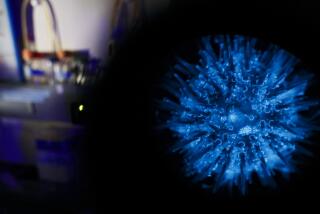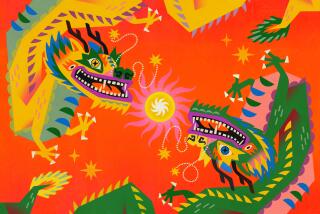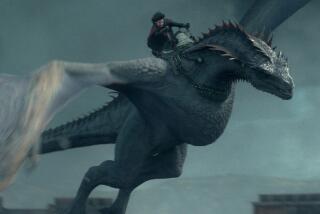Q&A: Want to build a dragon? A new book explains how to use gene editing to get it done
- Share via
Scientists are using gene-editing technologies to make mosquitoes that can’t spread malaria, combat diseases caused by a single errant letter in a string of DNA, and create designer babies who are protected against HIV.
They may be thinking too small. A father-daughter team is plotting the best way to create a dragon. They’ve even written a new book to explore how they’d do it.
In “How to Build a Dragon or Die Trying: A Satirical Look at Cutting-Edge Science,” UC Davis cell biologist Paul Knoepfler and his 17-year-old daughter Julie go through the biological traits they would mix and match from real animals to construct a creature that can fly and spit fire. Their blueprint includes genes from cows, eels and bombardier beetles.
In part, the new book is a way to poke fun at the hype surrounding the gene-editing system known as CRISPR. But it also gives them a chance to ponder the ethics — and wisdom — of tinkering with DNA in living creatures.
“You can do all these incredible things, but you should maybe take a step back,” said Julie, who just finished her junior year in high school and first explored the idea of building a dragon for a class project. “Do we need a dragon?”
The pair spoke with The Times about their dragon design dilemma, and why building a unicorn would actually be easier.
Your plan starts with the Draco lizard and the Komodo dragon. Why those two?
Paul: An important initial decision is this: Do you start from scratch or do you pick a creature that is kind of like a dragon already? If we start with another creature, we have a foundation to build on and we can change things to make it more like a dragon.
Draco lizards can glide through the air, but the downside is that they’re really tiny. The fact that they can almost fly is what captured us. We thought, maybe with CRISPR, if we can change its skin flaps into actual wings, it’ll seem like a little dragon.
Julie: Komodos are much bigger, and I think they’re what people associate more with dragons. But for them, flying would be so much harder because they weigh so much.
What features are most important to get your dragon to fly?
Paul: Body mass is really important. One common thing about animals that can fly is they tend to weigh a lot less than you might expect based on their size.
Flying creatures have skin flaps called patagia that act like a kite and catch the wind. If you look at human development, we start out in utero with some skin between our digits that goes away because of a process called apoptosis, where cells die. Ducks that have webbed feet don’t have the same cell death between their digits.
You could mutate a gene that is responsible for that self-destruction, so instead of dying, the cells would hang around and form the scaffold of the wing.
A dragon should breathe fire, and yours might do so with methane. Why methane?
Julie: A gas would probably be the best fuel source — it’s light, so it wouldn’t inhibit the flying. I thought, what is a gas that’s naturally occurring and produced by an animal? Cows and methane!
One thing that’s hard is that you think of dragons as carnivorous, and cows eat grass. I’m not sure what you would do about that. But the idea of an animal producing its own gas to make fire seemed like the best option.
How would you ignite the flames?
Julie: The head of a match is covered with a chemical called red phosphorus. When you strike it, there’s friction and it turns into white phosphorus, which then combusts in the air. I was thinking, maybe if the dragon’s tooth enamel had red phosphorus in it, and it can rub its teeth against each other, somehow it can produce white phosphorus to make fire.
Paul: Electric eels actually make their own electricity. They have cells called electrocytes that form electrical organs. If a dragon could have electrical organs, maybe on either side of its mouth, that could ignite the flammable gases it breathes out.
With CRISPR, we might introduce those genes into a Draco lizard.
Why is designing a fire-breathing animal so difficult?
Paul: There aren’t any real creatures that breathe fire, but bombardier beetles come closest because they shoot out this spray from their bottoms as a defense mechanism. It’s this really hot, caustic chemical concoction that’s almost as hot as boiling water.
Somehow, these beetles can make this spray naturally in their bodies. If you could do something similar but have it come out the mouth, that might be kind of like breathing fire.
Let’s say you could overcome all of the biological issues. What ethical issues would you need to consider?
Paul: There’s an inherent ethical dilemma in creating a new kind of creature. This gets to the dragon’s brain and intelligence. We would want it to be a pretty smart animal and have a certain level of awareness. But what if a dragon doesn’t want to act like a dragon, or it’s just miserable?
In my own lab, we make animals with unique sets of genes. We have to talk to bioethicists and ask if the goal of the research is worthwhile enough to justify the impact it might have on mice or birds.
Unfortunately, in real science that often doesn’t happen. A lot of scientists in other countries don’t necessarily think about the ethical issues — they just kind of plunge in.
If scientists are already using gene editing to tinker with animals today, is building a dragon such a far-fetched idea?
Julie: Pretty far-fetched, I think.
Making a unicorn would be easier. It’s just a horse with a horn on its head — there’s only one attribute you have to change. You see mammals with horns all over the place, but not winged reptiles.
This interview has been edited for length and clarity.







